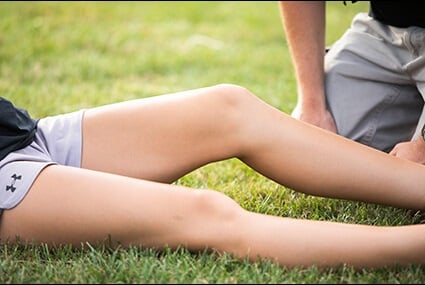Leg Injuries and Pain
Complete treatment for your leg injury

Anyone can experience a leg injury – an athlete, a weekend warrior, even an employee who carries around equipment. Teens and young adults most frequently experience leg injuries during sports or from accidental falls, while older adults have a higher risk of leg injuries because they lose muscle mass and bone strength as they age.
Our NovaCare Rehabilitation team offers you expert, compassionate care for your pain associated with:
- Femur shaft fracture
- Groin injury
- Hamstring injury
- Quadriceps strain
Regardless of your injury, the NovaCare Rehabilitation team will evaluate the injury or issue and develop a personalized treatment plan to get you on the road to recovery.
Leg injuries we treat
-
A femur shaft fracture — or broken thighbone — typically occurs during heavy collisions, such as car accidents, as the thighbone is the strongest bone in the body and takes a lot of force to break.
Common symptoms of a femur shaft fracture include:
- Immediate, severe pain
- Inability to bear weight
- The affected leg looking shorter than your other leg
-
A groin injury is when you strain or tear any of the muscles on the inner side of your thigh. The most common causes of a groin injury include sudden movements, such as twisting to change direction while running, kicking and jumping.
Symptoms of a groin injury include:
- Bruising
- Loss of strength in the upper leg
- Pain in the inner thigh
- Swelling
-
A hamstring injury involves either a strain or tear to the tendons or large muscles located at the back of the thigh. This injury can occur when you decelerate following a hard sprint or run.
Common symptoms of hamstring injuries include:
- Bruising
- Pain
- Tenderness
With a hamstring injury, it’s important that you work with a physical therapist to increase your range of motion and strengthen your hamstring and other muscles around it. This will not only help you alleviate symptoms, but also decrease your risk of experiencing a future hamstring injury.
-
Quadriceps strains involve a group of four muscles in your front thigh that connect to your knee right below the knee cap. Quadriceps strains typically occur due to the overuse of the muscles. Common symptoms of a quadriceps strain include:
- Bruising
- Pain
- Inflammation
- Tightness in the thigh
It's important to work with your physical therapist to learn and perform exercises to strengthen your quads and the muscles around them, as well as your balance and flexibility. This will help your recovery process and decrease the chances you experience a future quadriceps strain.

